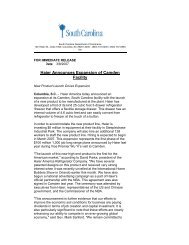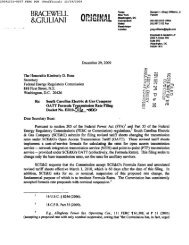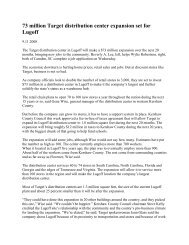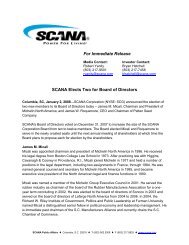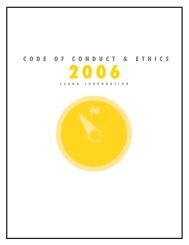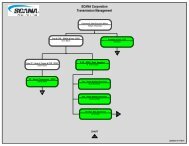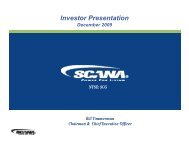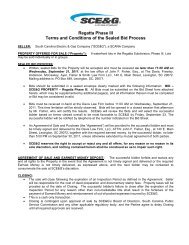10-K - SCANA Corporation
10-K - SCANA Corporation
10-K - SCANA Corporation
You also want an ePaper? Increase the reach of your titles
YUMPU automatically turns print PDFs into web optimized ePapers that Google loves.
Table of Contents<br />
As previously reported, SCE&G has been advised by Santee Cooper that it is reviewing certain aspects of its capital<br />
improvement program and long-term power supply plan, including the level of its participation in the New Units. Santee Cooper has<br />
entered into a letter of intent with Duke that may result in Duke acquiring a portion of Santee Cooper’s ownership interest in the New<br />
Units.<br />
The Consortium has recently performed an impact study, at SCE&G’s request, related to various cost and timing alternatives<br />
arising from the delay in the issuance date of the COL from mid-2011, which was the date assumed when the EPC Contract was<br />
signed in 2008, to the early-2012 issuance date currently anticipated by SCE&G. SCE&G has recently informed the Consortium that<br />
it intends to pursue the alternative that would delay the substantial completion date of the first New Unit and accelerate the substantial<br />
completion date for the second New Unit and has also begun discussions concerning the update of cash flow forecasts and<br />
construction schedules on that basis.<br />
In December 2011, the NRC granted final design certification to Westinghouse for the AP<strong>10</strong>00 nuclear reactor, which is the<br />
reactor to be used for the New Units. This certification is a necessary step before the NRC can issue a COL for the New Units. In<br />
October 2011, the NRC conducted a mandatory hearing regarding the issuance of a COL for the New Units. This hearing followed<br />
the August 2011 completion of the FSER, in which the NRC staff concluded there were no safety aspects that would preclude issuing<br />
the COL, and the April 2011 completion of the FEIS, in which the NRC and the USACE concluded there were no environmental<br />
impacts that would preclude issuing the COL.<br />
See additional discussion at OTHER MATTERS - Nuclear Generation.<br />
Environmental<br />
Significant federal legislative initiatives related to energy were unsuccessful in 2011, and Consolidated SCE&G expects such<br />
legislative initiatives will be hampered through 2012, due to each chamber of Congress being controlled by different political parties.<br />
The EPA, however, did issue new rules in 2011 related to air quality, including CSAPR and MATS, which require reductions in<br />
power plant emissions of sulfur dioxide, nitrogen oxide and mercury, among other substances. Though implementation of CSAPR<br />
was stayed by the United States Court of Appeals for the District of Columbia pending judicial review, Consolidated SCE&G cannot<br />
predict the outcome that judicial review will have on the rule’s implementation. In 2012, additional significant regulatory initiatives by<br />
the EPA and other federal agencies will likely proceed. These initiatives may require Consolidated SCE&G to build or otherwise<br />
acquire generating capacity from energy sources that exclude fossil fuels, nuclear or hydro facilities (for example, under an RES). It is<br />
also possible that new initiatives will be introduced to reduce carbon dioxide and other greenhouse gas emissions. Consolidated<br />
SCE&G cannot predict whether such initiatives will be enacted, and if they are, the conditions they would impose on utilities.<br />
The EPA has stated its intention to propose, in late 2012, new federal regulations affecting the management and disposal of<br />
CCR, such as ash. Such regulations could result in the treatment of some CCRs as hazardous waste and could impose significant costs<br />
to utilities, such as SCE&G and GENCO. The EPA is also expected to issue regulations during 2012 for cooling water intake<br />
structures to meet BACT at existing power generating stations. While Consolidated SCE&G cannot predict how extensive the<br />
regulations will be, Consolidated SCE&G believes that any additional costs imposed by such regulations would be recoverable<br />
through rates.<br />
Gas Distribution<br />
The Gas Distribution segment, comprised of the local distribution operations of SCE&G, is primarily engaged in the<br />
purchase, transportation and sale of natural gas to retail customers in portions of South Carolina. At December 31, 2011 this segment<br />
provided natural gas to approximately 317,000 customers in areas covering 22,600 square miles.<br />
Operating results for gas distribution are primarily influenced by customer demand for natural gas rates allowed to be<br />
charged to customers and the ability to control growth in costs. Embedded in the rates charged to customers is an allowed regulatory<br />
return on equity.<br />
Demand for natural gas is primarily affected by weather, customer growth, the economy and, for commercial and industrial<br />
customers, the availability and price of alternate fuels. Natural gas competes with electricity, propane and heating oil to serve the<br />
heating and, to a lesser extent, other household energy needs of residential and small commercial customers. This competition is<br />
generally based on price and convenience. Large commercial and industrial customers often have the ability to switch from natural gas<br />
to an alternate fuel, such as propane or fuel oil. Natural gas competes with these alternate fuels based on price. As a result, any<br />
significant disparity between supply and demand, either of natural gas or of alternate fuels, and due either to production or delivery<br />
disruptions or other factors, will affect price and impact SCE&G’s ability to<br />
92



